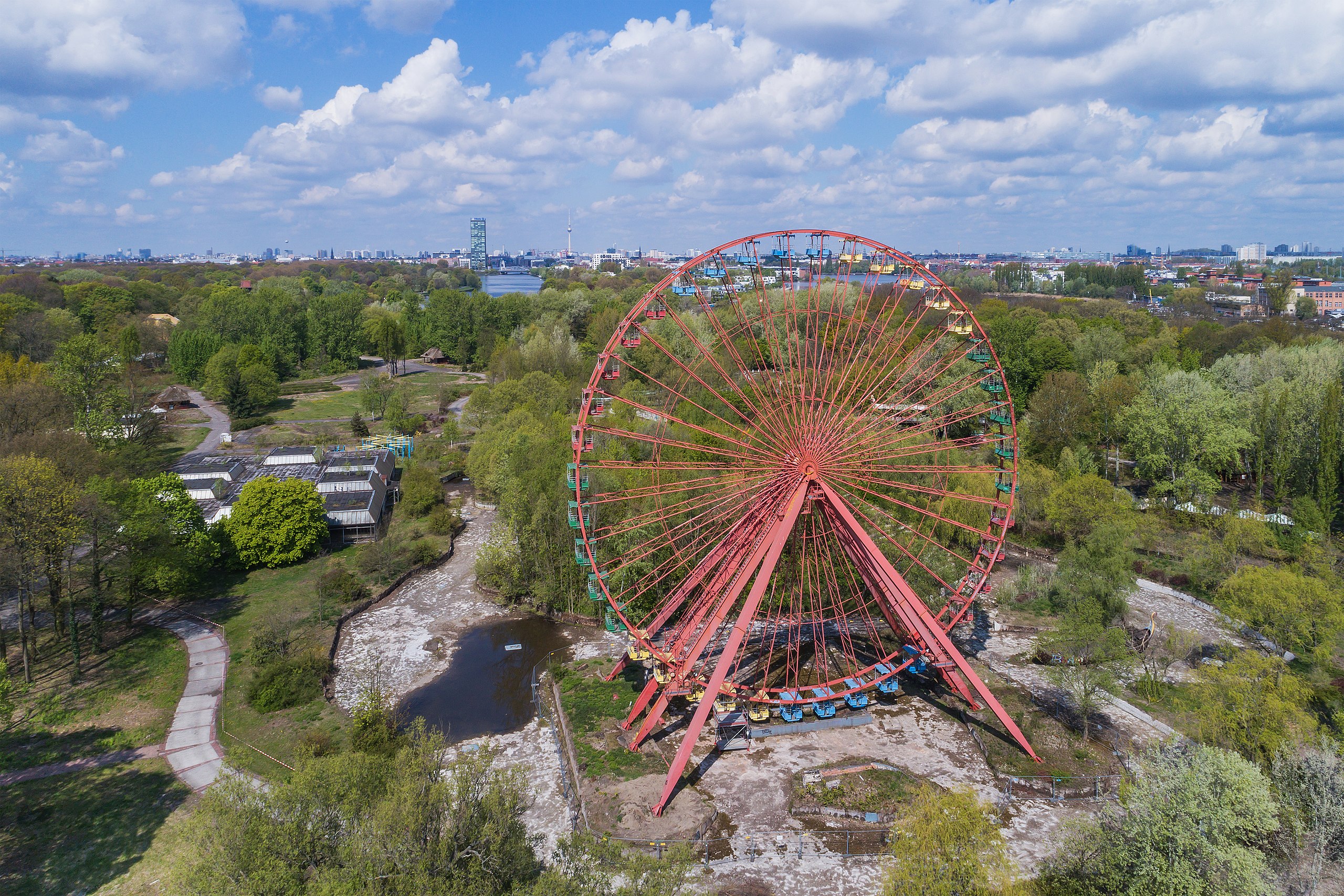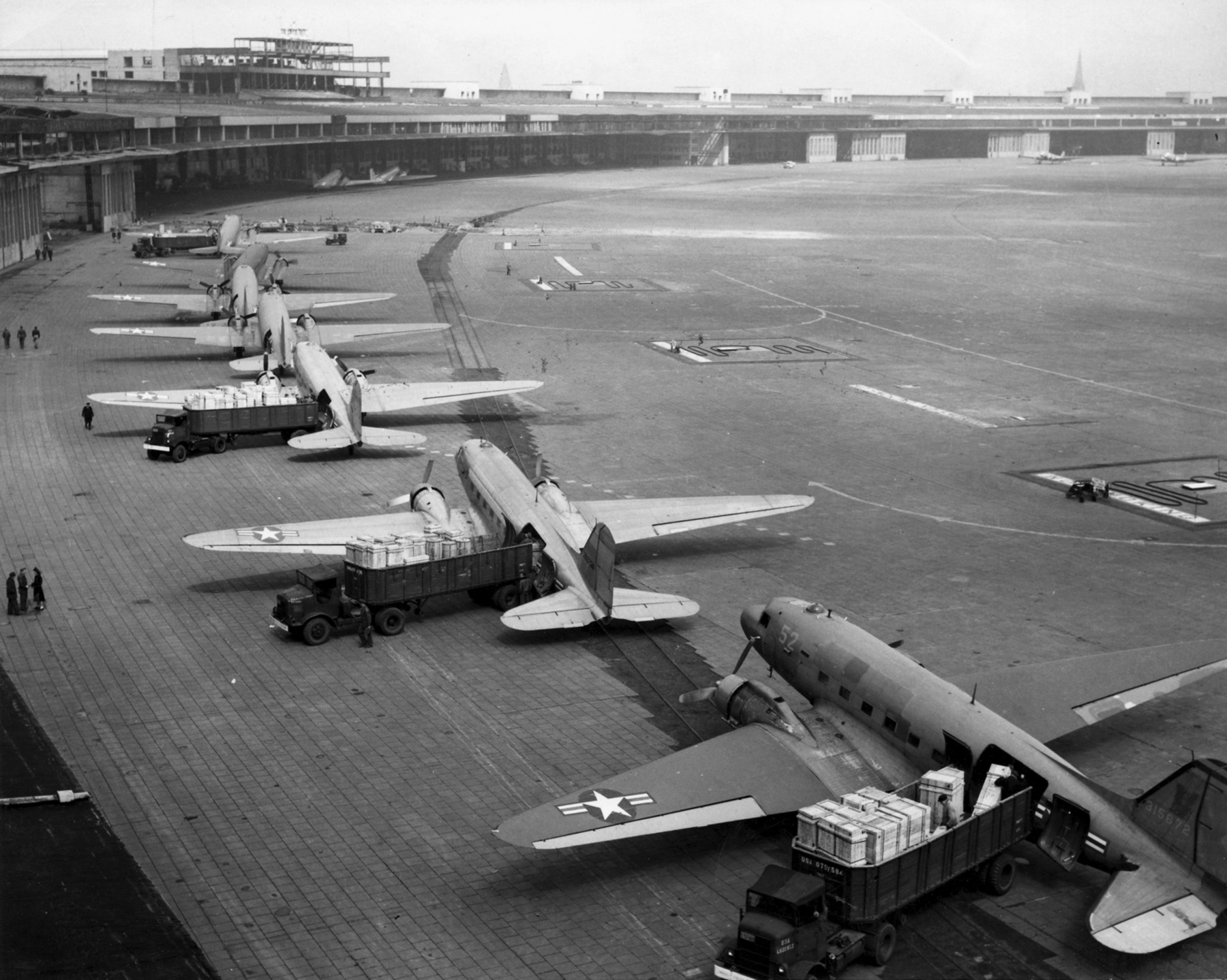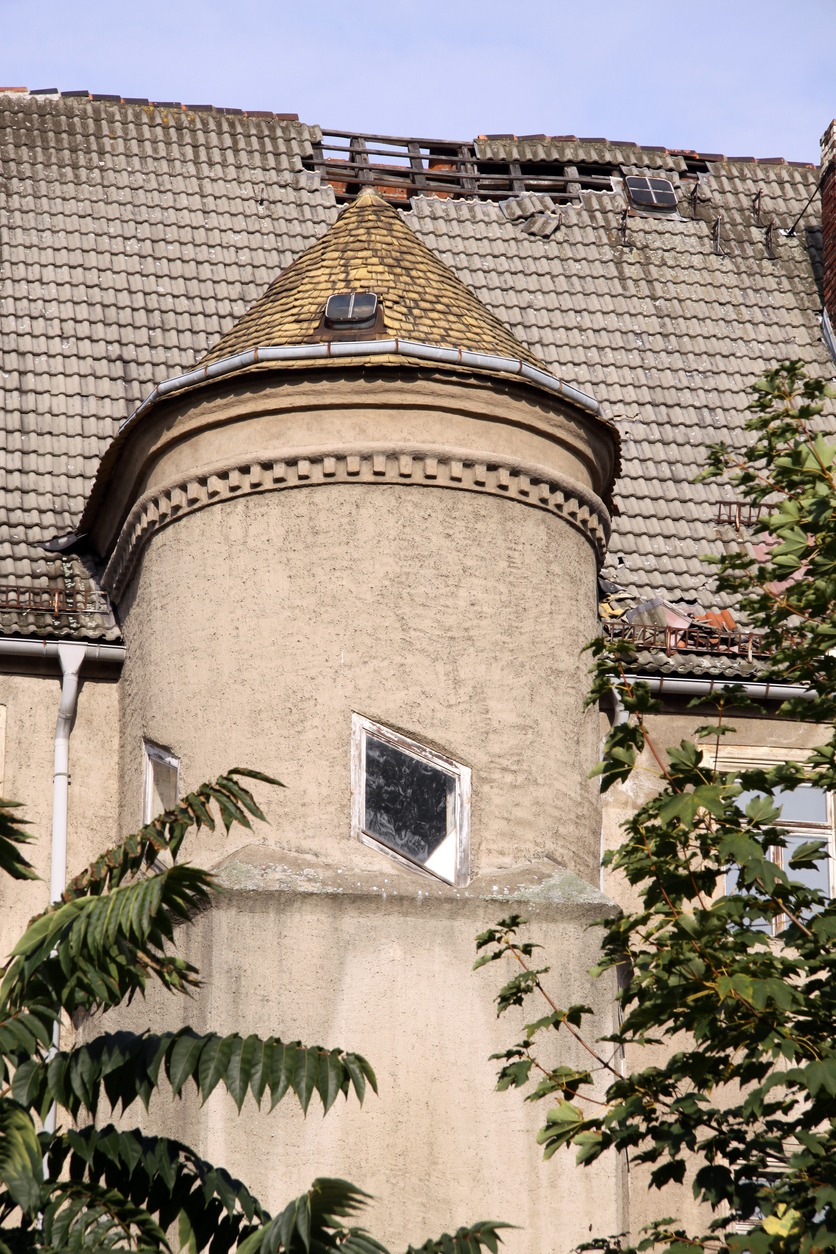Germany, with its rich and turbulent history, is home to numerous abandoned sites that whisper tales of the past. These places, ranging from eerie churches and vast military bases to relics of the Cold War, offer a unique window into the country’s complex history. This blog post will take you on a journey through some of Germany’s most fascinating abandoned places.
Spreepark: A Deserted Amusement Park
Once a thriving entertainment venue in East Berlin, Spreepark was an amusement park that closed its doors in 2002. Its rusting rides, including a Ferris wheel that still eerily turns in the wind, and overgrown pathways create a post-apocalyptic scene. The park, with its decaying attractions, tells a story of entertainment, abandonment, and the economic shifts following German reunification.
The entertainment park was opened in 1969 as Kulturpark Plänterwald, covering an area of 29.5 hectares. The area is situated in the north of the Plänterwald, next to the river Spree.
It was the only constant entertainment park in the GDR, and the only such park in either East or West Berlin. Since 2002 the park has not opened for visitors. In August 2002 the park was declared completely insolvent. since then, it has been left to rot away, and is now one of the worlds most famous abandoned parks.
One of the world’s more photogenic derelict fun-zones, this district of toppled dinosaurs, rusted Ferris wheels and vandalized swan boats operated for 20 years as Kulturpark Plänterwald in the former East Berlin before becoming Spreepark in the wall-toppling year of 1989. Although the reason the park was shuttered isn’t exactly scandalous — good, old-fashioned insolvency — what happened to its former owner, Norbert Witte, is.
Olympisches Dorf von 1936, Elstal
An abandoned NSA spying station in Berlin
Teufelsberg (German for Devil’s Mountain) is an artificial hill in west Berlin built by Second World War rubble. On top of that hill is where the American National Security Agency (NSA) built one of its largest listening stations. ‘The Hill’, as it was known to American soldiers, began operation in 1961 while a permanent construction was built in 1963. It remained active until the fall of East Germany and the Berlin Wall, but after that the station was closed and the equipment removed.
A group of investors bought the hill in the early 90s from the City of Berlin with the intention to build hotels and apartments but this never happened. Today, the buildings and radar domes still remain in place.
Abandoned Churches: Echoes of the Past
Germany’s landscape is dotted with numerous churches that have been abandoned over time. These sacred structures, once centers of community and worship, now stand as hauntingly beautiful monuments to a bygone era. From Gothic cathedrals with their soaring spires to small village chapels, these churches often lie in various states of decay, their altars and pews gathering dust and their once-vibrant stained glass windows shattered. They serve as poignant reminders of shifting populations, changing religious practices, or the ravages of war.
Beelitz-Heilstätten: A Hospital Frozen in Time
Perhaps one of the most famous abandoned places in Germany is the Beelitz-Heilstätten hospital complex. Located southwest of Berlin, this extensive complex of about 60 buildings was originally built as a sanatorium in the late 19th century. It later served as a military hospital during both World Wars. The hospital is infamously known for treating Adolf Hitler during WWI. After the fall of the Berlin Wall, most of the buildings were abandoned, leaving behind a sprawling ghost town. Today, its eerie corridors and crumbling wards attract urban explorers and photographers from around the world.
Spread across 200 acres of woodland south of Potsdam, this sprawling sanatorium is a veritable treasure trove for urban explorers.
The construction of Beelitz-Heilstätten began in 1898, in response to the prevalence of Tuberculosis. Architect Heino Schmeiden designed the sanatorium in accordance with the ‘pavilion plan’ – four distinct quadrants segregating the men from the women, and the quarantined patients from those with non-infectious diseases. A 600-bed state-of-the-art treatment facility equipped with spacious south-facing balconies opened in 1902, closely followed by several additional buildings, bringing the total patient capacity up to 1,200 and expanding the complex to include a number of service buildings, amenities, and even its own power plant.
Throughout WW1, Beelitz-Heilstätten served as a field hospital for the Imperial German Army, treating over 12,500 wounded soldiers, including none other than Adolf Hitler. It was following the defeat of Nazi Germany in 1945 that the Soviet Army commandeered the hospital. They remained in control for 50 years, withdrawing in 1995, long after the fall of the Berlin wall. Attempts were then made to privatise the hospital, but without great success and so, with the exception of one part of the complex which has been restored as a clinic for neurological patients, the once bustling buildings now stand empty.
Berlin Tempelhof Airport: An Aerial Relic
Berlin Tempelhof Airport, once among the 20 largest buildings in the world, ceased operations in 2008. Known for its monumental Nazi-era architecture and its role in the Berlin Airlift during the Cold War, the airport is now a public park, with its runways used for recreational activities. The massive terminal building, with its deserted hangars and silent runways, offers a glimpse into aviation history and the changing political landscapes of the 20th century.
Built in 1923, Berlin-Tempelhof closed to passengers in October 2008. Until the construction of the Pentagon, it was the largest building in the world. It played a key role in the Berlin Airlift but over the years it became obsolete. Today ‘Tempelhof Field’ is the largest public park in the city and the airport buildings host events such as raves and fashion shows.
Military Bases: Remnants of Wars
Germany’s strategic position in Europe resulted in numerous military bases, particularly during the Cold War. Many of these bases, once bustling with soldiers and military activity, now sit empty. These include both Nazi-era bases and those used by NATO forces during the Cold War. Their abandoned barracks, hangars, and training facilities provide a stark reminder of Germany’s military past.
Honecker’s Nuclear Bunker: A Hidden Fortress
One of the most secretive places during the Cold War was the nuclear bunker built for East Germany’s leader, Erich Honecker. Located north of Berlin, this bunker was designed to withstand a nuclear attack. Its underground tunnels and rooms, once filled with state-of-the-art technology and life-support systems, now lie empty and silent, a hidden testament to Cold War fears and preparations.
Codenamed 17/5001, this secret bunker was one of the communist world’s most advanced bunkers, built to protect the leaders of the former East Germany from a nuclear attack but it was never actually used.
The three-storey bunker was built in a forest 25km (16 miles) north-east of Berlin, near Wandlitz, where the the East German government was accommodated in a special colony. The bunker reaches a depth of 70m (230ft) below ground. 85,000 tonnes of concrete were used while a four metre thick ‘blast cap’ over the bunker was designed to protect from explosions above. Complex filters shielded the bunker’s occupants from radioactive or biological agents.
Its submarine-like tunnels divided by heavy metal doors lead on to 170 rooms. It was fitted with a fountain, power generators, air conditioning and “springed” rooms able to cushion residents from detonations. Over
Its construction began in secret in 1978 and finished in 1983, It was intended to house the East Germany leader Erich Honecker who ruled the German Democratic Republic (GDR) for almost two decades and 400 staff. It is rumoured that Honecker himself visited the bunker only once and wasn’t happy with its environment.
Although urban explorers had found a way to enter inside earlier, the bunker opened for the first time to the public and for only 3 months in 2008, with its walls now covered in mould and the decontamination chambers long-defunct.
Heeresversuchsanstalt Peenemünde
- Location and History: Situated on the Usedom island in the Baltic Sea, this was Nazi Germany’s largest and most significant military research center.
- Significant Developments: It was here that the V-2 rocket, the world’s first long-range guided ballistic missile, was developed and tested, marking a significant advancement in military technology.
- Post-War Use: After World War II, the facility was seized by Soviet forces and continued to be used for military purposes before being abandoned.
- Legacy: The site is now a museum, offering insights into the history of rocket technology and its impact on the space race.
Altes Lager (Münsingen Training Area)
- Location: Located in Baden-Württemberg, it was primarily used by the German Army and later by NATO forces.
- Training and Operations: The area served as a key training ground for various military operations, featuring extensive barracks and training facilities.
- Current State: Now abandoned, the area has become an eerie landscape of decaying military structures surrounded by nature.
- Ecological Significance: The site has gained attention for its unique ecosystem, which has thrived in the absence of human activity.
Krampnitz Military Complex
- Architectural Significance: Located near Potsdam, this complex is known for its imposing Nazi-era architecture, including grand buildings and parade grounds.
- Usage: Initially built for the German Army, it was later used by Soviet forces until the 1990s.
- Abandonment: After the fall of the Soviet Union, the base was abandoned, leaving behind a vast ghost town of military structures.
- Cultural Impact: The site has been used as a filming location for various movies due to its authentic historical ambiance.
Vogelsang Military Base
- Strategic Importance: This base in Brandenburg was a major Soviet military installation during the Cold War.
- Facilities: It included extensive barracks, training areas, and a complex network of supporting facilities.
- Post-Soviet Era: Following the withdrawal of Soviet troops, the base was abandoned, with many structures left intact but decaying.
- Future Plans: There have been discussions about repurposing the site, but many buildings remain in a state of disrepair.
Wünsdorf-Waldstadt
- The Forbidden City: Known as “The Forbidden City,” it was one of the largest Soviet military camps outside the Soviet Union.
- Facilities: The camp included a vast array of military buildings, cultural centers, schools, and even theaters, making it a self-sufficient community.
- Cultural Exchange: Despite being a closed military area, it was a center for Soviet culture in Germany.
- Present-Day: The site is now largely abandoned, with guided tours available to explore its extensive, ghostly remains.
Oranienburg Bombing Range
- Historical Use: Initially used by the Luftwaffe during WWII, this site in Brandenburg became a key bombing range.
- Soviet Era: Post-war, it was utilized by the Soviet Air Force for training and bombing exercises.
- Remnants of War: The area is littered with remnants of military exercises, including craters and abandoned structures.
- Current Status: Now abandoned, it serves as a stark reminder of the area’s military past, with nature slowly reclaiming the land.
These military sites across Germany not only provide a glimpse into the country’s military history but also offer a unique perspective on how such places evolve post-abandonment, often becoming sanctuaries for wildlife or sites of historical interest and cultural memory.
Teufelsberg NSA Spying Station: A Cold War Relic
Teufelsberg, or Devil’s Mountain, located in the Grunewald Forest in Berlin, is an artificial hill built from the rubble of WWII bombings. Atop this hill sits the abandoned NSA spying station, used by the US during the Cold War to intercept Soviet communications. The radar domes and dilapidated buildings are now covered in graffiti, creating a surreal landscape that draws the curious and those interested in espionage history.
There are other man made rubble mounds through out Europe but this one is unique because underneath the rubble lies the unfinished Wehrtechnische Fakultät, a Nazi military technical college. The school was designed by architect Albert Sperr and proved faultless when the Allies tried to demolish the building using explosives.
The building would not falter so it was decided to just cover it with debris. Initially it was sought to make Teufelsberg as high as the natural elevation of Großer Müggelberg but it is in fact taller, measuring 394 feet tall, 17 feet taller than Großer Müggelberg. ‘The Hill’ is the name Teufelsberg earned from American soldiers who worked there beginning in 1961, when the US National Security Agency built one of its largest listening stations on top of Teufelsberg. In 1963, construction of a more permanent facility on top of Teufelsberg began and continued monitoring the Soviet, East German and other Warsaw Pact nations military traffic.
At the end of East Germany in 1990, the Field Station Berlin was decommissioned. The land was bought afterwards by a group of German investors who wanted to transform the listening station into hotels and apartments. There was talk to turn the listening station into a spy museum but as the land and station have become encumbered with a mortgage of nearly 50 million dollars.
Abandoned Buildings and Places: Vestiges of Time
Across Germany, numerous other buildings and places have been left to the mercy of time. This includes schools, factories, and even entire villages that were deserted for various reasons, such as economic downturns, environmental disasters, or demographic changes. These sites, each with their unique history and atmosphere, continue to captivate those who visit them.
A Unique Place – An abandoned 1920s cabaret Theatre in Berlin
This abandoned cabaret theatre was discovered in the central Mitte area of Berlin, Germany. It opened in 1905 as a musical hall and restaurant, named “Fritz Schmidt’s Restaurant and Festival Halls” and soon became an established venue for Berlin’s ballroom society. In 1919 it changed operators and became “Kolibri Festival Halls and Cabarets”. It was the era of the German “Kabarett” and that was when this theatre hall had some of its best days. It all ended at some point after 1934 when the Nazi regime started its crackdown on the cabaret scene.
The cabaret theatre was found inside an abandoned three-storey building surrounded by taller apartment buildings. After tons of rubble were removed from its interior, a 300 square metre (3230 sq feet) ballroom with wall paintings and metre-high stuccoed ceilings was revealed. The kitchen on the ground floor had a special lift to send up food and drinks to the hall on the second floor. LAVA architecture firm undertook the task of restoration of the building in order to be used as a space for performances and exhibitions, studios, meetings and conferences, and luxury apartments for short term and executive rental.
Conclusion
The abandoned places of Germany offer more than just a glimpse into the past; they are open-air museums that tell stories of war, healing, entertainment, and political strife. Exploring these sites is a journey through history, where the walls do indeed talk, and the air is thick with the echoes of bygone days. For urban explorers, history enthusiasts, or anyone fascinated by the passage of time, Germany’s abandoned places are a treasure trove of discovery, offering endless opportunities for exploration and reflection.




